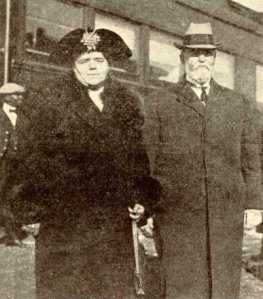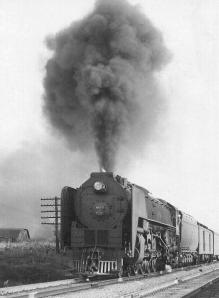by Engineman Preserved Wook
In The Pictorial Encyclopedia Of Railways (Hamlyn, revised edition 1976), Hamilton Ellis writes on p 113 that among the most accomplished of mechanical engineers of Victorian steam locomotives was William Adams. Perhaps Adams’s single biggest contribution was a pivoted bogie that had a sidewise-sliding instead of fixed center pin; this allowed the wheels at their flanges more truly, precisely and steadily to follow rail curvature.
Also, and this is what caught my eye because of my interest here at Engineman Wook in late-modern and early-postmodern steam locomotive design re-engineering, Ellis says that Adams “was sound on front-end [smokebox] design and produced the once-famous Adams Vortex blastpipe”. As I know that Andre Chapelon, L D Porta and, today, David Wardale all have done work on this, I wanted to know more about their high modern antecedents; it is acknowledged from time to time for example that Chapelon at the end of WW I took his first inspiration for blastpipe redesign from the work of (more…)
Archive for the ‘The Great Railwaymen’ Category
William Adams & The Adams Vortex Blastpipe
Posted in The Great Railwaymen on October 21, 2010| Leave a Comment »
L D Porta & The Rebirth Of Postmodern Steam Locomotion
Posted in The Great Railwaymen on September 24, 2010| Leave a Comment »
by Engineman Wook
“By the time that Porta [b 1922 — ed] had completed his technical studies in Buenos Aires in 1946, the classic mainline steam locomotive was in its final stage of development. On the New York Central, Paul Kiefer had just produced his mighty Niagara 4-8-4s, magnificent and brutally functional machines capable of running at 100 mph on level track with 16-car trains on tight schedules between New York and Chicago, and clocking up 28,000 miles a month. Exhaustive tests proved them every bit as economical, and a great deal more powerful, than the latest diesels.”
This quote is from an topflight short account for lay readers of the work of Livio Dante Porta and the postmodern protagonists of twenty-first century steam locomotion, at this Gloucestershire Transport History link:
http://glostransporthistory.visit-gloucestershire.co.uk/maximumLDPorta.htm
*****
[Engineman Wook
[all rights revert to holders
[23 September 2010]
The Life & Writings of Ingeniero Livio Dante Porta
Posted in The Great Railwaymen on July 30, 2010| Leave a Comment »
by Engineman Wook
*****
“Nobody knows what they don’t know until they know it…. Then there is what in Brazil is called The Office Theory: What I don’t understand is necessarily wrong.”
[Argentine steam locomotive design engineer L D Porta, in “My Difficulties”, infra qv]
“In 1601, Giovanni Battista della Porta described a machine that could be used to raise a column of water with the use of steam. He described this machine in a work entitled ‘Spiritali.’ Porta’s work included a vacuum created by the condensation of steam into which water would flow. Porta’s apparatus…was called the ‘Pneumatica.’ Porta’s machine was described as being able to raise water with steam pressure. Although Porta’s machine was never applied to any practical uses, he accurately described the necessary presence of a vacuum created by steam to raise the water.”
[from The Steam Engine
[ http://campus.udayton.edu/~hume/Steam/steam.htm ]
*****
So, who was this early-modern Giovanni Battista Porta? And was he, could he have been, a forebear of the sorcerer of the postmodern 21st century Second Steam Railroading Age, Ingeniero Livio Dante Porta? Quien sabe? As Borges points out often, there are many (more…)
Fundamental Principles of Steam Locomotive Modernisation & Their Application
Posted in The Great Railwaymen on July 29, 2010| Leave a Comment »
by Livio D. Porta, Consulting Engineer
[Porta’s lucid piece is re-posted here in the pp of Engineman Wook as a matter of on-line information redundancy, from the yeoman pp of GLOUCESTERSHIRE TRANSPORT HISTORY:
[ http://glostransporthistory.visit-gloucestershire.co.uk/index.html
[The fact that English was not Porta’s first language, and that the text following has been trampled by at least two halfwits, myself included, in trying to insure clarity, only attests the invincible achievement of the original author — PW]
*****
Modernisation is defined as the partial application of technological advances to existing locomotives without the introduction of structural changes. And it is a myth that the steam locomotive reached a pinnacle imposed by its very nature.
French locomotive designer Andre Chapelon was the first to realise this from 1926 onwards, and the author, his disciple, continued the work. Whilst (more…)
Ralph Paine Johnson
Posted in The Great Railwaymen on December 9, 2009| Leave a Comment »
by Engineman Wook
I am just now finishing reading again for the first time in sixty-some (!) years the classic technical survey of steam locomotive railroading by PRR design engineer Ralph Paine Johnson. It is the Simmons-Boardman 1942 The Steam Locomotive: Its Theory, Operation and Economics, Including Comparisons with Diesel-Electric Locomotives.
If we are “all on the same page here,” as our young folks like to say, then you too will know that Johnson superintended development in WW II of the PRR duplex steam locomotives. Duplex engines were rigid frame engines driven by four or more simple or compound cylinders. Q1 was a dud because of surge problems and forward-facing after cylinders that swept road grit and dirt. But Johnson’s team’s 4-4-6-4 Q2 is a classic locomotive indeed, and perhaps the REAL rhinoceros of the American steam locomotive of the last steam age in the World.
Some rhinocerosoid and Johnsonian numbers indeed! From Wikipedia: http://en.wikipedia.org/wiki/PRR_Q2
Builder: PRR Altoona shops
Build date: 1944–45
Total production: 26
Configuration: 4-4-6-4
UIC classification: 2’BC2′
Gauge: 4 ft 8+1⁄2 in (1,435 mm)
Leading wheel size: 36 in (910 mm)
Driver size: 69 in (1,800 mm)
Wheelbase: 26 ft 4.5 in (8.039 m) (driving)
Wheelbase: 20 ft 4 in (6.20 m) (rigid)
Wheelbase: 53 ft 5.5 in (16.294 m) (locomotive)
Wheelbase: 107 ft 7.5 in (32.804 m) (locomotive and tender)
Length: 124 ft 7.125 in (37.97618 m) (locomotive and tender)
Width: 11 ft 4 in (3.45 m) (storm windows open)
Height: 16 ft 5.5 in
Weight on drivers: 393,000 lb (178,000 kg)
Weight: 619,100 lb (280,800 kg)
Tender weight: 430,000 lb (200,000 kg)
Locomotive and tender combined weight: 1,049,100 lb (475,900 kg)
Tender type: PRR class 180F84, 8 axles, with conductor “doghouse”
Fuel type: Soft coal
Fuel capacity: 39.86 long tons (40.50 t)
Water capacity: 19,020 US gal (72,000 l; 15,840 imp gal)
Boiler pressure: 300 lbf/in²
Front cylinder size: 19¾ in × 28 in
Rear cylinder size: 23¾ in × 29 in
Power output: 7,987 hp (5,956 kW)
PRR unit numbers: 6131, 6175–6199
Last run: 1951
Pennsylvania Railroad duplex steam locomotives, including the T1 4-4-4-4 and the 6-4-4-6 S1 as well as the Q2 series, and all built at (more…)
L F Loree
Posted in The Great Railwaymen on November 16, 2009| Leave a Comment »
by Preserved Wook
The following biographical precis is from the online pp of:
http://www.steamindex.com/people/american.htm
Leonor Fresnel Loree was born in Fulton City, Illinois, on 23 April 1858 and died in West Orange, New Jersey on 6 September 1940. He was a civil engineer and railway executive. Educated at Rutgers College, he worked both for the Pennsylvania Railroad and the US Army Corps of Engineers. In 1884 he became engineer of maintenance of way, Indianapolis and Vincennes division of the Pennsyvania RR, and in 1888 in its Pittsburgh division. This division, with its heavy traffic in ore and coal transiting a railway of many curves, was considered a severe operating problem.
Loree increased operating efficiency, introducing the lap siding. His continued professional progress led to him being made general manager of Penn Lines West in 1896, and fourth vice president in 1901. Early in 1901 the Pennsylvania acquired a controlling interest in the Baltimore & Ohio to which Loree was elected vice president. His innovations and leadership resulted in much improved efficiency and co-operation with other railroads.
Loree moreover introduced Walschaerts valve gear and Mallet locomotives in the first decade of a new century, its bright promise not yet blighted by late-modern (more…)


